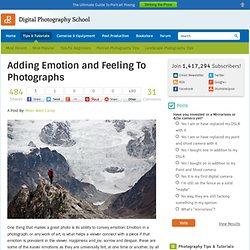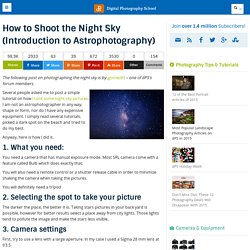

A 15 Minute Exercise To Help You Improve Your Photography in 2012. A Post By: Darren Rowse Here’s a little exercise for you to do today.

It will only take 15 minutes. It’s all about slowing down and thinking about the shots that you’re taking. 10 Things I Learnt from Daily Shooting. 10 Ways to Develop Yourself Photographically. What Separates Great Photographers from Good Ones? 5 Ideas to Kick Start Your Photography Again. A Post By: Darren Rowse Image by Eric May Last week I was speaking with an amateur photographer who told me that he’s been struggling for photographic inspiration and ideas lately.

He reflected that he felt like he’d become something of a lazy photographer and was in a bit of a rut – always photographing the same things in the same ways. 5 Key Skills for the Modern Photographer. A Guest post by Saul Molloy from Shotslot.

Image by Romain Ballez All the whistles and bells of the modern camera should, at least in theory, make crafting great images an easier and more straightforward process than it used to be – with all these exposure modes, focussing tools, picture styles and the like, camera manufacturers would like you to believe that it’s just a matter of squeezing the shutter and hey presto you’re Bailey.
Certainly getting the tricky business of exposure right has become more straightforward for the technologically challenged – you really don’t need to know much to get some passable snapshots but what about if you want to take your photography further? Photography is so very different an activity from that of even ten years ago. 6 Ways to Enhance Your Creativity.
5 ways to stop being a luck photographer {and start taking pictures on purpose} How to Take Photos that Stand Out from the Crowd. I think this is a valuable piece of information to pass along to both newcomers to photography and the more experienced crowd… Perhaps the best piece of advice I can provide which will immediately improve one’s photography and cause it to stand out from the countless other photos on the web, is to act unusual while taking the photos.

By Ryan Pendleton If you’re standing upright, pointing your camera at obvious subjects, from obvious perspectives, at obvious times the day, the resulting photographs will be nothing more than…obvious. Your photos will not differentiate themselves, as is the intentions of so many photographers. Everyone wants ‘different’ images that catch the public’s eye. Many of my best photos were taken with at least one (and sometimes several) person staring at me as if I were a closed-head injury patient who happened to find a DSLR lying on the side of the road. The next time you’re out with your camera, try the following: 1. 2. 3. 4. 5. A Simple Exercise to Train your Photographic Eye. A Post By: Valerie Jardin Park Bench Here is a simple exercise you can do anywhere that will help develop your photographic eye.

Take your camera with just one lens and go for a walk (of course any point and shoot camera will do the trick too). While walking down the street, at the park or even in the wilderness, make a point to stop randomly and find something to photograph within 10 or 15 feet (3 to 5 m) from where you are standing. 3 Stupidly Simple Reasons Why Most Peoples Photography Does Not Improve. I’m presuming that this article will not apply to some readers of dPS… but after 3 conversations in the last week which revealed the same photography problems in 3 different people – I thought I’d better jot them down.

Warning: none of this is rocket science sometimes the basics need to be said! 1. You don’t Take Your Camera With You. 3 Workouts to Improve your Photography. A Guest post by Jim Harmer of ImprovePhotography.com Athletes would never consider showing up to a game without having practiced, so why is it that most photographers shoot for the “wall-hanger” photo every time they go out without ever practicing new techniques? Consider applying these new workouts in your photography routine and you will improve your skills and creativity. 1.
The EXIF Drilldown In my photography workshops, I often show my portfolio to introduce myself before the class begins. The very best way to shoot like a pro is to analyse the work of the pros, and Flickr is just the place to look. To view this information on Flickr, find a photo and click the small text link on the top right of the screen that reads the name of the camera that shot the picture. This photography workout simply requires going to Flickr or any other photo sharing website, finding good photos, and then carefully reviewing the EXIF data from the pictures. 2. 3. 7 Tips For Great Low Angle Shots. Adding Emotion and Feeling To Photographs. A Post By: Peter West Carey One thing that makes a great photo is its ability to convey emotion.

Emotion in a photograph, or any work of art, is what helps a viewer connect with a piece if that emotion is prevalent in the viewer. Happiness and joy, sorrow and despair, these are some of the easier emotions as they are universally felt, at one time or another, by all on this planet. Emotion, or a feeling, is what can bring a snapshot out of obscurity and make it shine. Think of a normal sunset picture from the shores of Hawaii with just the horizon and a bright orange sun dipping low. An Introduction to Tilt-Shift Photography. Focusing Quick Tip: Single Point AF Methods. A Post By: James Brandon One of the biggest leaps towards tack sharp images you can take is using single point auto focus to hone in on your subject and nail the shot.

Using the automatic grid focus system can sometimes be like throwing a handful of darts and hoping to hit the bullseye, especially when shooting at an extremely shallow depth of field like f/1.4. In fact at f/1.4, if you’re subject is 5 feet away and you’re shooting with a 50mm prime, your depth of field is only 0.09 feet! How to Shoot the Night Sky (Introduction to Astrophotography) The following post on photographing the night sky is by jgomez65 – one of dPS’s forum members.

Several people asked me to post a simple tutorial on how I took some night sky pictures. I am not an astrophotographer in any way, shape or form, nor do I have any expensive equipment. I simply read several tutorials, picked a dark spot on the beach and tried to do my best. Anyway, here is how I did it. 1. Knowing My Limits Why I Dont Do HDR.
The Only Tip Youll Need for Creating a More Interesting and Well-Rounded Set of Images of Any Destination or Subject. What Every Photographer Needs to Know About Facebook. A Post By: Darren Rowse A Guest Post by Alison Zarrella – co-author of The Facebook Marketing Book. 2011 is shaping up to be a big year for photography on Facebook.

Their New Profile highlights images above practically all else, and allows for some pretty creative customization with images. Facebook has also added the option to upload high resolution photos, and expanded the maximum number of photos in one album from 60 to 200. Photography has historically been an area where Facebook excels, and for good reason. 10 Tips for Mastering Instagram. A Post By: Christina N Dickson I have a confession. Yes. I love taking photos. Yes. Minimalism: Using Negative Space In Your Photographs. A Post By: James Brandon Sometimes it’s nice and refreshing to just strip a photo or scene down to it’s absolute bare essentials.
Often times, I get too caught up in trying to fill every part of the frame with something interesting. The problem is, sometimes when we try to fill up the entire frame with objects, lines, people, shapes, etc, we actually overcomplicate things and leave the viewer wanting a place to rest their eyes. How to Take Long Exposure Shots in Daylight.
Strobist. Digital Photography Tips: Digital Photography School. Digital Photography Tips from the Top Floor - Free MP3 Audio and Video, Learn Photography, Photo Workshop! Home - PhotoWalkthrough. Photodoto. CS 178 - Digital Photography. Course materials Course schedule (click here for the lecture notes) Course description (meeting time, units, prereqs, etc.) Course outline (textbooks, coursework, grading policies, etc.) Archive of class business (the "What's new? " 4 Steps To Mastering Creative Night Photography.
1.2K Flares1.2K Flares × Your Complete Guide For Photographing Star Trails. Ever seen those pictures where the stars streak across the sky in a big arc? Top 10 Photography Hacks. How Can I Take Better Photos in Low Light? Take Better Photographs by Studying an Egg. How To Create An Image Map Using GIMP. There are several pieces of design software that can help a designer to create an image map, but many of them are very expensive.
Get Real, Useful Photography Critiques at 1x.com. Digital photography HOWTO roundup. Learn Photography. Types of Cameras Point and Shoot (P&S) - This is the type of camera that is often very thin. P&S cameras generally don't have options on them for controlling shutter speed, aperture, ISO, etc. They are fully automatic, and usually have a large LCD screen on the back (digital) for taking a picture. Advanced P&S - This is the kind of camera you will want to start with. They are small, but resemble DSLRs, they may have a flip up flash, handle, etc. SLRs - SLR stands for Single Lens Reflex, if there is a "D" in front of it, than it means a Digital Single Lens Reflex.
Picking the one for you *Note* Megapixels are not the way to chose a camera. Graphy tips and techniques: articles and guides from Photo.net.